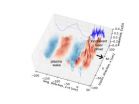(Press-News.org) Making a tabletop particle accelerator just got easier. A new study shows that certain requirements for the lasers used in an emerging type of small-area particle accelerator can be significantly relaxed. Researchers hope the finding could bring about a new era of accelerators that would need just a few meters to bring particles to great speeds, rather than the many kilometers required of traditional accelerators. The research, from scientists at the U.S. Department of Energy's (DOE) Lawrence Berkeley National Laboratory (Berkeley Lab), is presented as the cover story in the May special issue of Physics of Plasmas.
Traditional accelerators, like the Large Hadron Collider where the Higgs boson was recently discovered, rely on high-power radio-frequency waves to energize electrons. The new type of accelerator, known as a laser-plasma accelerator, uses pulses of laser light that blast through a soup of charged particles known as a plasma; the resulting plasma motion, which resemble waves in water, accelerates electrons riding atop the waves to high speeds.
The problem, however, is creating a laser pulse that's powerful enough to compete with the big accelerators. In particular, lasers need to have the capability to fire a high-energy pulse thousands of times a second. Today's lasers can only manage one pulse per second at the needed energy levels.
"If you want to make a device that's of use for particle physics, of use for medical applications, of use for light source applications, you need repetition rate," explains Wim Leemans, physicist at Berkeley Lab. In January of 2013, the DOE held a workshop on laser technology for accelerators. At the time, says Leemans, the big question was how to get from the current technology to the scaled up version.
Conventional wisdom holds that many smaller lasers, combined in a particular way, could essentially create one ultra powerful pulse. In theory, this sounds fine, but the practical requirements to build such a system have seemed daunting. For instance, it was believed that the light from the smaller lasers would need to be precisely matched in color, phase, and other properties in order to produce the electron-accelerating motion within the plasma. "We thought this was really challenging," says Leemans, "We thought, you need this nice laser pulse, and everything needs to be done properly to control the laser pulse."
But the new Berkeley Lab study has found this isn't the case. Paper co-authors Carlo Benedetti, Carl Schroeder, Eric Esarey and Leemans wanted to see what an erratic laser pulse would actually do inside a plasma. Guided by theory and using computer simulations to test various scenarios, the researchers looked at how beams of various colors and phases—basically a hodgepodge of laser light—affected the plasma. They soon discovered, no matter the beam, the plasma didn't care.
"The plasma is a medium that responds to a laser, but it doesn't respond immediately," says Benedetti, a physicist at Berkeley Lab. The light is just operating on a faster time scale and a smaller length scale, he explains. All of the various interference patterns and various electromagnetic fields average out in the slow-responding plasma medium. In other words, once laser light gets inside the plasma, many of the problems disappear.
"As an experimentalist for all these years we're trying to make these perfect laser pulses, and maybe we didn't need to worry so much," says Leemans. "I think this will have a big impact on the laser community and laser builders because all of a sudden, they'll think of approaches where before hand all of us said, 'No, no, no. You can't do that.' This new result says, well maybe you don't have to be all that careful."
Leemans says the ball is back in the experimentalists' and laser builders' court to prove that the idea can work. In 2006, he and his team demonstrated a three-centimeter long plasma accelerator. Where a traditional accelerator can take kilometers to drive an electron to 50 giga-electron volts (GeV), Leemans and team showed that a mini-laser plasma accelerator could get electrons to 1 GeV in just three centimeters with a laser pulse of about 40 terawatt. To go to higher electron energies, in 2012, a larger more powerful laser was installed at the Berkeley Lab Laser Accelerator (BELLA) facility with a petawatt pulse (1 quadrillion watts) that lasts 40 femtoseconds, which is now being used in experiments that aim at generating a 10 GeV beam.
Still, the goal of a high-repetition rate, 10-GeV laser-plasma accelerator that fires a thousand pulses or more per second, is at least five to ten years away, says Leemans. But a new project called k-BELLA (k is for kilohertz) is in the works that will use the principles of combined, messy laser light sources to produce fast, more powerful laser pulses. "Once we synthesize a pulse at higher repetition rates," says Leemans, "we will be on our way towards a kilohertz GeV laser plasma accelerator."
INFORMATION:
This work was supported by the DOE Office of Science and used the facilities of the National Energy Research Scientific Computing Center (NERSC) located at Berkeley Lab.
Lawrence Berkeley National Laboratory addresses the world's most urgent scientific challenges by advancing sustainable energy, protecting human health, creating new materials, and revealing the origin and fate of the universe. Founded in 1931, Berkeley Lab's scientific expertise has been recognized with 13 Nobel prizes. The University of California manages Berkeley Lab for the U.S. Department of Energy's Office of Science. For more, visit http://www.lbl.gov.
The National Energy Research Scientific Computing Center (NERSC) provides high-end scientific production computing resources for DOE's Office of Science researchers, supporting work in a wide range of disciplines that span the DOE missions. For more information visit http://www.nersc.gov.
DOE's Office of Science is the single largest supporter of basic research in the physical sciences in the United States and is working to address some of the most pressing challenges of our time. For more information, please visit the Office of Science website at science.energy.gov/.
A path toward more powerful tabletop accelerators
Laser light needn't be as precise as previously thought to drive new breed of miniature particle accelerators, say Berkeley Lab researchers
2014-05-28
ELSE PRESS RELEASES FROM THIS DATE:
PTSD treatment cost-effective when patients given choice
2014-05-28
A cost-analysis of post-traumatic stress disorder treatments shows that letting patients choose their course of treatment – either psychotherapy or medication – is less expensive than assigning a treatment and provides a higher quality of life for patients.
In a recent study, published in the Journal of Clinical Psychiatry, PTSD patients allowed to choose between therapies ended up costing about $1,622 less on average per patient per year compared with patients who were assigned treatment. Among patients not given a choice, treatment with prolonged exposure psychotherapy ...
Technology marketers should take consumer life-cycle into account: New Rotman study
2014-05-28
Toronto – If you want grandpa to start using the bank machine instead of standing in line for the teller, the best way to do it is to tell him to "Act now!" with a limited time offer for a banking card, shows new research.
A new study from the University of Toronto's Rotman School of Management suggests marketers should pay attention to where consumers are in their lifecycles when determining how to get them to adopt new technologies.
Marketers may have incorrectly assumed that older consumers avoid products such as debit or credit cards because they are technophobic ...
Supersonic spray delivers high quality graphene layer
2014-05-28
A simple, inexpensive spray method that deposits a graphene film can heal manufacturing defects and produce a high quality graphene layer on a range of substrates, report researchers at the University of Illinois at Chicago and Korea University.
Their study is available online in the journal Advanced Functional Materials.
Graphene, a two-dimensional wonder-material composed of a single layer of carbon atoms, is strong, transparent, and an excellent conductor of electricity. It has potential in a wide range of applications, such as reinforcing and lending electrical ...
NASA sees northern Indian Ocean System 92B's end
2014-05-28
The tropical low pressure area known as System 92B finally dissipated on the east central coast of India on May 27 after six days of struggling to develop. System 92B developed in the Bay of Bengal, Northern Indian Ocean basin on May 21. NASA's TRMM, Aqua and Suomi NPP satellites captured data on the low throughout the ups and downs it experienced until wind shear finally took its toll on the system.
NASA and the Japan Aerospace Exploration Agency's Tropical Rainfall Measuring Mission (TRMM) satellite passed over System 92B on May 19 and 20 and captured data on System ...
Lethal injection comes under new scrutiny after botched execution
2014-05-28
The botched execution in April of a man convicted of murder brought to the fore of national consciousness the precarious state of capital punishment. An article in Chemical & Engineering News (C&EN), the weekly news magazine of the American Chemical Society, details the history of lethal injection, what went wrong in April and how states are currently handling the practice, once deemed the most humane way to execute prisoners.
Jyllian Kemsley, a senior editor at C&EN, explains that the three-compound procedure prison officials use to carry out executions by lethal injection ...
Brazilian researchers find human menstrual blood-derived cells 'feed' embryonic stem cells
2014-05-28
Tampa, Fla. (May 28, 2014) – To be suitable for medical transplantation, one idea is that human embryonic stem cells (hESCs) need to remain "undifferentiated" i.e. they are not changing into other cell types. In determining the best way to culture hESCs so that they remain undifferentiated and also grow, proliferate and survive, researchers have used blood cell "feeder-layer" cultures using animal-derived feeder cells, often from mice (mouse embryonic fibroblasts [MEFs]). This approach has, however, been associated with a variety of contamination problems, including pathogen ...
Can Tai Chi slow the aging process?
2014-05-28
Putnam Valley, NY. (May 28, 2014) – Tai Chi, a traditional Chinese martial art and sport, has been found to be beneficial in raising the numbers of an important type of cell when three groups of young people were tested to discover the benefits of Tai Chi, brisk walking or no exercise. The group performing Tai Chi saw a rise in their cluster of differentiation 34 expressing (CD34+) cells, a stem cell important to a number of the body's functions and structures.
The study was published in issue 23(4/5) of Cell Transplantation and is freely available on-line at: http://www.ingentaconnect.com/content/cog/ct/2014/00000023/F0020004/art00020.
"To ...
Scientists control rapid re-wiring of brain circuits using patterned visual stimulation
2014-05-28
In a new study, published in this week's issue of the journal Science, researchers show for the first time how the brain re-wires and fine-tunes its connections differently depending on the relative timing of sensory stimuli. In most neuroscience textbooks today, there is a widely held model that explains how nerve circuits might refine their connectivity based on patterned firing of brain cells, but it has not previously been directly observed in real time. This "Hebbian Theory", named after the McGill University psychologist Donald Olding Hebb who first proposed it in ...
Acute concern for health, environment highlighted at UN-backed E-waste Academy in Latin America
2014-05-28
Acute concerns about e-waste management in developing countries were highlighted in expert presentations at a recent E-waste Academy for Managers (EWAM) in El Salvador organized by UN University Institute for the Advanced Study of Sustainability (UNU-IAS) hosted Step (Solving the E-Waste Program) Initiative.
The week-long Academy ended April 4 was the second in a series inaugurated in Ghana in 2012. By sharing insights on "urban mining" and fostering international linkages and collaboration, the academies for e-waste managers, along with complementary events for e-waste-related ...
Cats found to eat more in the winter
2014-05-28
Cats eat more during the winter and owners should give their pet more food during this time, University of Liverpool research has found.
Researchers from the University's School of Veterinary Science, in collaboration with colleagues at the Royal Canin Research Centre in France, spent four years monitoring how much cats chose to eat, and found that food intake increased in colder months and decreased during the summer.
The 38 cats studied had a microchip on their collar which allowed them to take as much food as they wanted from a dispenser which only opened for them. ...
LAST 30 PRESS RELEASES:
Ecology: Mummified cheetahs discovery gives hope for species’ Arabic reintroduction
Researchers survey the ADHD coaching boom
Air pollution and cardiac remodeling and function in patients with breast cancer
Risk of suicide in patients with traumatic injuries
Post–intensive care syndrome
The lifesaving potential of opioid abatement funds
The Frontiers of Knowledge Award goes to Allan MacDonald and Pablo Jarillo-Herrero for their discovery of the “magic angle” enabling science to transform and control the behavior of new materials
Discovery reveals how keto diet can prevent seizures when drugs fail
JMIR Publications and Sikt announce pilot flat-fee unlimited open access partnership
Finding new cell markers to track the most aggressive breast cancer in blood
A new, cleaner way to make this common fertilizer
Fire-safe all-solid-state batteries move closer to commercialization
Disinfecting drinking water produces potentially toxic byproducts — new AI model is helping to identify them
Unplanned cesarean deliveries linked to higher risk of acute psychological stress after childbirth
Healthy aging 2026: fresh pork in plant-forward diets supported strength and brain-health biomarkers in older adults
Scientists identify pre-cancerous states in seemingly normal aging tissues
Itaconate modifications: mechanisms and applications
Potential tumor-suppressing gene identified in pancreatic cancer
Winners of the 2026 Hill Prizes announced
Autonomous AI agents developed to detect early signs of cognitive decline
Study finds ocean impacts nearly double economic cost of climate change
Increased deciduous tree dominance reduces wildfire carbon losses in boreal forests
Researchers discover how a respiratory bacterium obtains essential lipids from the human body and targets fat-rich tissues
Locust swarms destroy crops. Scientists found a way to stop that
More resources and collaboration needed to support prevention and treatment of obesity
Two types of underconfidence linked to anxiety and gender
Insects are victims too: Global study shows impacts of invasive alien species on populations
Pioneering natural, degradable polymer capsules
Forestry is becoming digital and automated
Maternity baby deaths much higher in northern England than in the South
[Press-News.org] A path toward more powerful tabletop acceleratorsLaser light needn't be as precise as previously thought to drive new breed of miniature particle accelerators, say Berkeley Lab researchers




